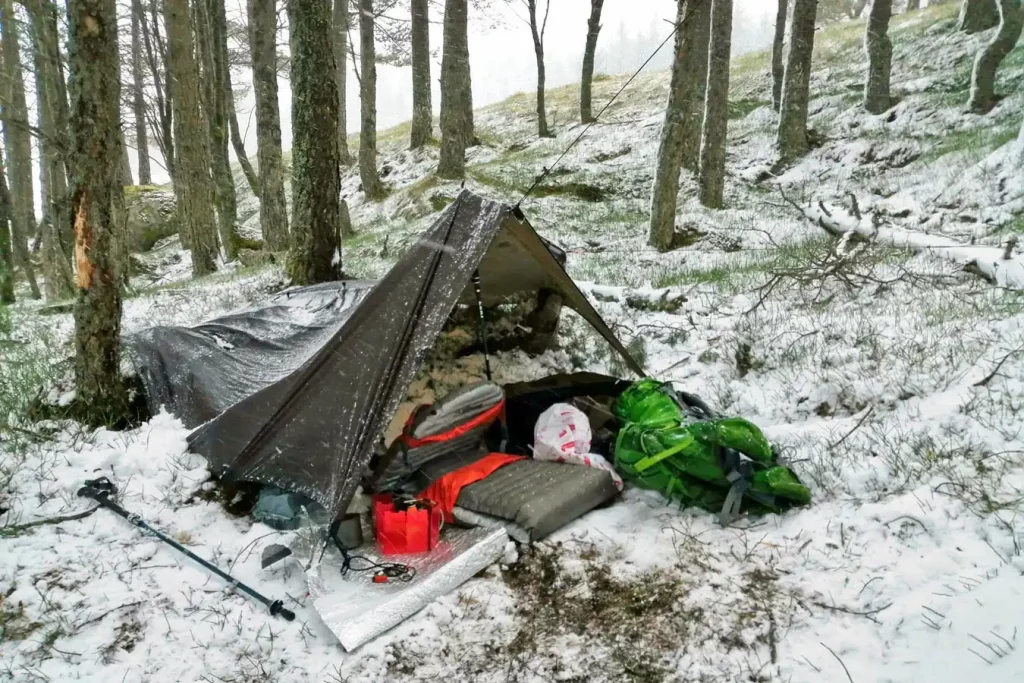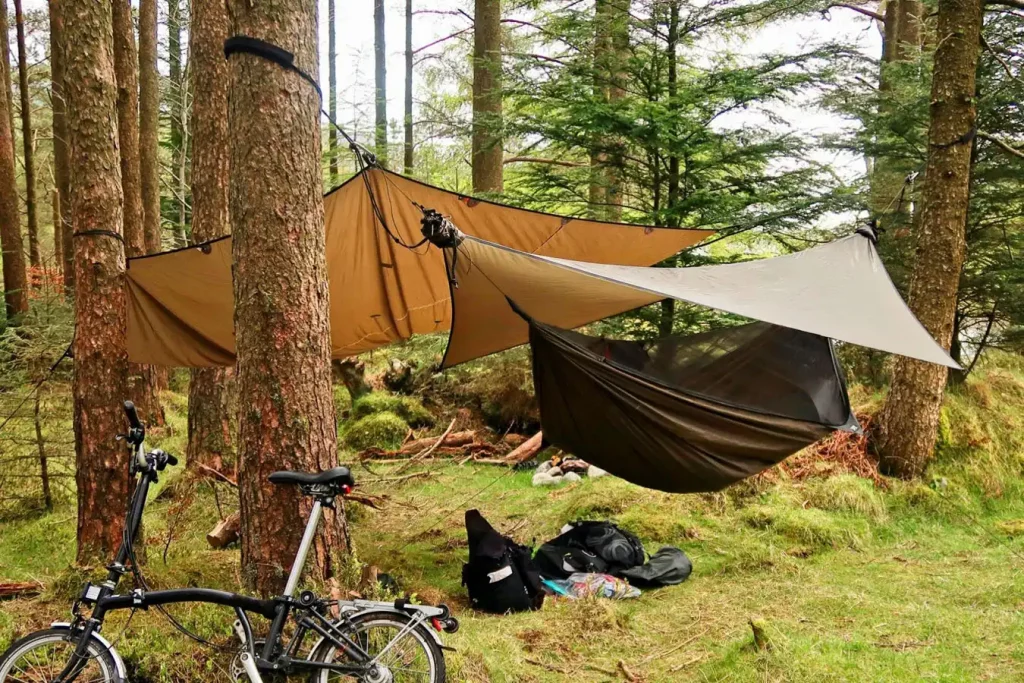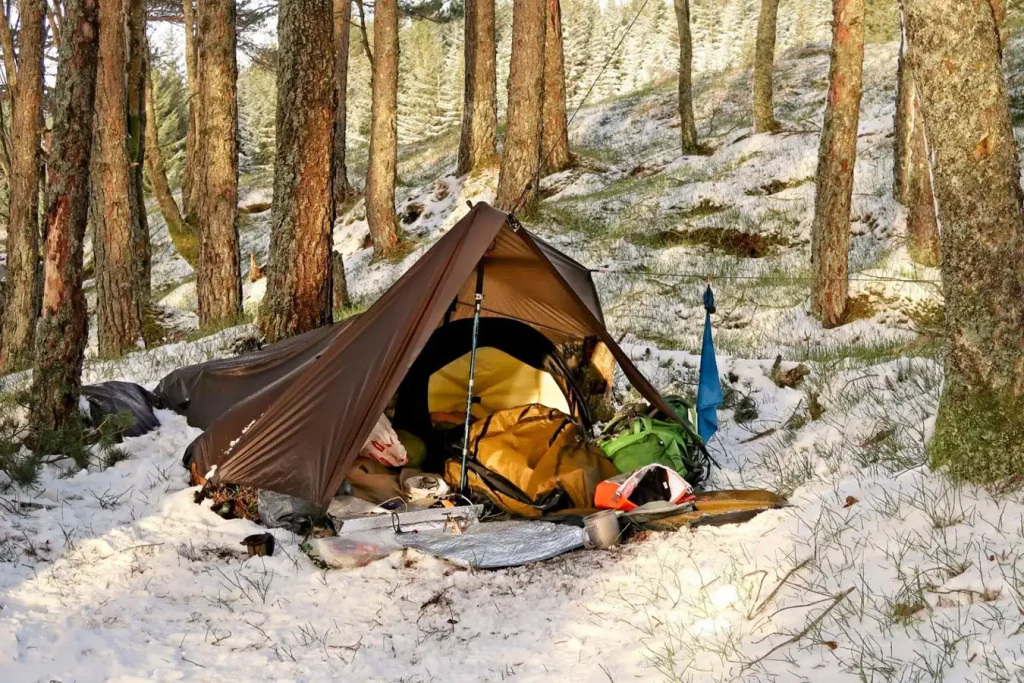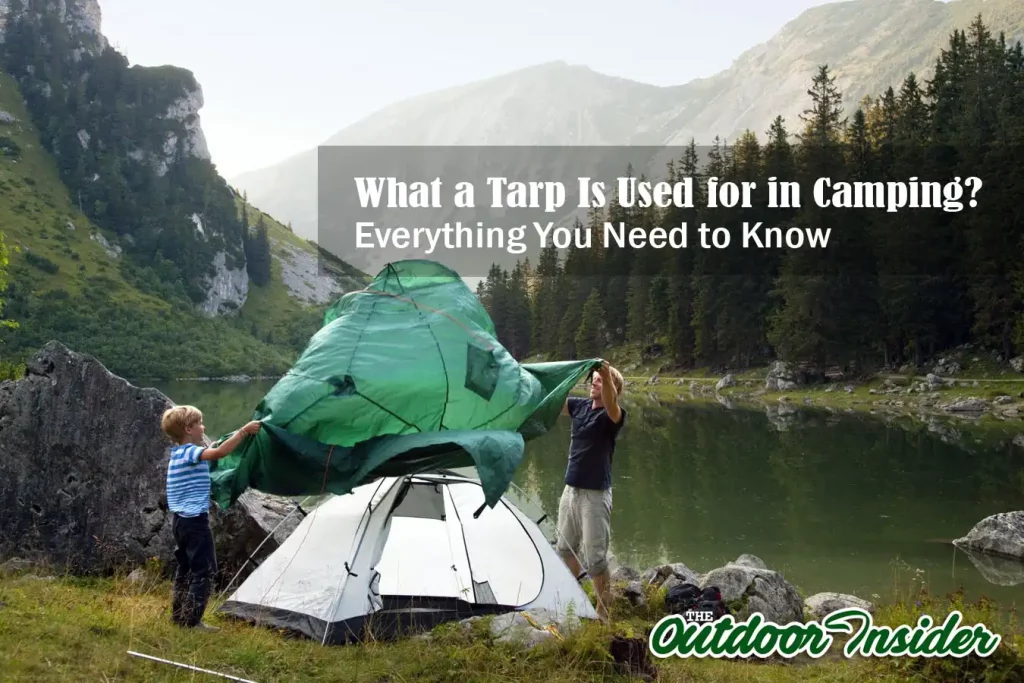When exploring what a tarp is used for in camping, the possibilities are virtually endless.
From serving as a barrier against the cold, wet ground, to a shelter from harsh weather conditions, tarps are a camper’s best friend.
In this guide, we’ll unveil the hidden secrets of using a tarp in your camping endeavors, offering practical tips and tricks along the way.
Settle in and prepare to master the art of camping with this versatile piece of gear!
What is a Tarp?
A tarp, short for tarpaulin, is a durable, water-resistant sheet made of materials like polyethylene, canvas, or vinyl. Often fitted with grommets at the corners and edges for secure tie-down, it is used for protection and shelter against weather elements, particularly in outdoor settings like camping. Tarps is also used for hot tent camping.

The Importance of Tarps in Camping
Now that you know what a tarp is, let’s chat about why it should be on your camping gear checklist. Picture yourself hiking through the woods, the sun is setting, you’ve found the perfect spot to camp, and there’s a tarp tucked away in your backpack. The importance of this unsung hero starts to unfold.

1. Protecting Against Rain and Moisture
Imagine waking up in the middle of the night, soaked to the skin because rain decided to pay a surprise visit. Doesn’t sound like fun, right? Enter: tarp. Rigging a tarp over your tent can act as a frontline shield against unexpected downpours, keeping you dry and comfortable. Plus, it can act as a moisture barrier if placed under your tent, keeping the dampness of the ground from seeping in.
2. Creating Shelter and Shade
Ever craved a bit of shade during a hot day on your camping trip? With a tarp and a little bit of creativity, you’ve got yourself a makeshift shelter! It can be the roof of your open-air kitchen, a cozy reading nook, or simply a spot to relax and enjoy nature while shielded from the scorching sun or even drizzles.
3. Covering Camping Gear and Equipment
Picture this: you’re out exploring nature, and when you return, your gear is soaked or covered in leaves and debris because you left it out. A tarp can double up as a protective layer for your gear, ensuring that your cooking equipment, firewood, and other outdoor essentials stay dry and clean. A camping day saved by our trusty tarp!
4. Enhancing Privacy and Security
If you’re at a bustling campsite, a tarp can provide that little bit of privacy you might crave. Positioned strategically, it’s like a temporary fence giving you your own private space. And while it might not be Fort Knox, a tarp can also provide a visual barrier to keep your belongings out of sight and offer a bit more security.
5. Multipurpose Uses
But wait, there’s more! The versatility of a tarp is its superpower. Need a makeshift picnic blanket? Tarp’s got your back! Emergency rain poncho? Tarp to the rescue! A temporary carry bag? You guessed it, mold your tarp into one. There’s a reason I like to call it the Swiss army knife from Amazon as a camping equipment.
Types of Tarps for Camping
Every tarp has different versions, right? Well, so does our camping tarp – the tarp. There are several types of tarps made from different materials, each boasting their own set of features and benefits. Let’s get to know them a bit better.
1. Polyethylene Tarps
Starting with the most common type, polyethylene tarps. These are your everyday, friendly neighborhood tarps.
They’re lightweight, easy to handle, and water-resistant. This makes them ideal for protecting your gear from sudden rain showers or for setting up quick, short-term shelters. And here’s the kicker – they’re relatively inexpensive, making them great for those on a budget.

2. Canvas Tarps
Next up, we’ve got canvas tarps. These are the old-school, reliable type.
They’re highly durable, breathable, and can resist wind better than their counterparts. If you’re going to a windy spot or need a tarp for heavy-duty use, canvas tarps are your go-to. They might be heavier and less portable, but they’re a sturdy companion for tough weather conditions.
3. Vinyl Tarps
If you’re looking for the strong, silent type, consider vinyl tarps.
These are stronger and more durable than poly tarps, making them ideal for harsh conditions. They’re waterproof, UV resistant, and tear-resistant. While they might be a bit pricier, their strength and longevity make it a worthy investment for regular campers.
4. Mesh Tarps
Need something a bit more breathable? Look no further than mesh tarps.
These tarps allow air to flow through while providing shade and protection against debris. They’re perfect for hot and sunny conditions where you need a shield from the sun without trapping the heat underneath. Ideal for creating a comfy, shady spot to relax in the great outdoors.
5. Silnylon Tarps
Lastly, we have the lightweight champion – silnylon tarps.
These tarps are ultra-lightweight, waterproof, and packable, making them a backpacker’s best friend. They might not be as robust as vinyl or canvas tarps, but they’re perfect for backpacking trips where every ounce matters.
Comparing and contrasting the tarps and usage:
| Types of Tarps for Camping | Key Features |
| Polyethylene Tarps | Lightweight, waterproof, UV-resistant, cost-effective |
| Canvas Tarps | Breathable, durable, heavy-duty, not prone to condensation |
| Vinyl Tarps | Strongest, waterproof, UV and tear-resistant, suitable for extreme weather |
| Mesh Tarps | Provides shade while allowing airflow, UV-resistant, lightweight |
| Silnylon Tarps | Ultralight, waterproof, compact, good for backpacking |
To know more: What You Need to Know about Tent Camping
Common Uses of Tarps in Camping
In the world of camping, tarps are the Swiss Army knives, they’re multi-faceted, adaptable, and they always come in handy. Let’s dive into the top ways you can put your tarp to use in your camping adventures.
1. Shelter and Protection
Imagine you’re in the heart of the woods, the wind picks up, and you feel the first drop of rain. Fear not, with a tarp, you’ve got yourself a pop-up shelter. Simply tie the corners to trees or poles, and voila – you’ve got a roof over your head, protecting you from rain, wind, or even a bit too much sunshine.
2. Ground Cover
Nobody wants to wake up from their cozy camping sleep to a pool of water in their tent. That’s where your tarp comes in. Place it under your tent as a ground cover and it works like a charm to prevent moisture from the ground seeping in, keeping your sleeping area dry and cozy.
3. Rainfly and Tent Extensions
Think of this as a super-sized umbrella for your tent. By suspending a tarp over your tent, you can shield it from rain or dew, making a rainfly. Or use it as a tent extension, creating an extra covered space where you can relax, shielded from the elements.
4. Emergency Situations
Your tarp is like that reliable friend who’s got your back in times of need. If your tent gets damaged, a tarp can serve as an emergency tent. It can also be used as a stretcher in the direst situations. It’s the superhero cape you never knew you needed!
5. Storage and Organization
Got some extra gear or firewood that you need to keep dry and organized? A tarp is your answer. Lay it out, place your items on top, and fold it up – you’ve got yourself a makeshift storage bag. Or you can hang it up to create a protective cover for your gear.
6. Cooking and Dining Area
Set a tarp over your cooking and dining area, and you have an outdoor kitchen that’s shielded from the elements. No more worrying about rain putting out your fire or sun beating down on your perfect picnic spread. Bon appétit!
Learn more: What you need to know about to Live in a Camper in the Winter
Choosing the Right Tarp for Camping
A tarp might just seem like a piece of fabric, but selecting the right one for your camping needs is a fine art. You see, the difference between a soggy, miserable camping trip and a cozy, happy one can often be chalked up to choosing the right tarp. Let’s delve into the factors you should consider when picking out your camping tarp.
1. Size and Shape
Choosing the right size and shape for your tarp boils down to its intended use. Are you looking for a quick, sheltering roof? A large rectangular or square tarp could be perfect. Need a protective groundsheet for your two-person tent? A smaller one would suffice. Remember, while larger tarps offer more coverage, they also take up more packing space and might be overkill for small campsites.
2. Material and Durability
In the camping world, your tarp needs to be tough – like, tarp tough. Whether it’s bearing the brunt of a rainstorm or shielding you from the blazing sun, it’s got a big job to do. So, pick a material that matches your camping conditions. From the rugged canvas to the lightweight silnylon, each material offers a unique blend of durability, waterproofing, and weight.
3. Grommets and Tie-Downs
Grommets and tie-down points are the unsung heroes of your tarp. These are the points you’ll be using to secure your tarp, so check their quality and the distance between them. More tie-downs give you more flexibility in setting up your tarp, and reinforced grommets help ensure that it won’t rip or tear when you’re braving a windy night.
4. Weight and Portability
Camping is about being one with nature, not lugging around heavy gear that makes you want to sprint back to civilization. So, consider the weight and packed size of the tarp. If you’re backpacking or hiking to your campsite, a lightweight, compact tarp made from materials like silnylon or polyethylene can be your best friend.
Choosing the right tarp can make your camping trip a walk in the park (or, more fittingly, a walk in the woods). So consider these factors, pick the right tarp, and get ready to embrace the great outdoors.
Learn more: What to Put Under Air Mattress When Camping
How to Use a Tarp in Camping?
Sure, we’ve covered what a tarp is and why it’s your camping tarp. But how do you make the most of it? Let’s unwrap the secrets of tarp usage.
1. Setting up a Tarp Shelter
Setting up a tarp shelter can seem like an intimidating origami project. But with a little practice, you can turn your tarp into a snug retreat. The steps are simple. Pick a spot between trees (or use poles if trees aren’t available), secure the tarp using the grommets and tie-downs, and adjust the tarp’s angle and tension depending on the weather. Voila! You have your very own outdoor living room.
2. Securing and Anchoring Tarps
Properly securing and anchoring your tarp is crucial to withstand wind and other elements. Use strong, quality ropes and stakes, and make sure you pull the tarp tight to avoid any flapping or pooling of water. When tying down your tarp, always start from the center and work your way outward, adjusting the tension as you go.
3. Tarp Maintenance and Care
Your tarp is a loyal friend, and like any good friendship, it requires care. Clean your tarp after each trip, ensuring it’s free of debris before storing it. Always dry it thoroughly to avoid mold or mildew growth. Small rips and tears? Repair kits are available to patch them up. Handle with care, and your tarp will return the favor.
Read more: What is a 3 Season Tent
Tips and Tricks for Tarp Usage
Got the basics down? Now, let’s move onto some tarp wizardry. Here are some handy tips and tricks for tarp usage that will level up your camping game.
- Location! Choosing the right spot for your tarp is crucial. Avoid low-lying areas where water can gather. Instead, opt for a higher, flat surface that will keep you dry, even in a downpour.
- Wind direction matters. To minimize wind resistance, align your tarp shelter with the direction of the wind. This positioning will prevent the wind from lifting your tarp or causing it to flap noisily.
- Create a taut, secure setup. A sagging tarp isn’t just unappealing – it’s also less effective against rain. Use ropes and stakes to pull your tarp tight, reducing any sag and preventing water from pooling.
- Practice makes perfect. Set up your tarp at home before your camping trip. This dry run lets you get comfortable with different configurations and spot potential problems, saving you time and stress at the campsite.
- Lastly, remember to keep your tarp clean and dry after each use. Proper care will extend its lifespan and ensure it’s ready for your next outdoor adventure.
To know more: Learn How to Stay Warm on an Air Mattress
FAQs About What a Tarp is Used for in Camping
Why do you need a tarp for camping?
What to do with a tarp when camping?
What is the point of a tarp?
Do you put a tarp under or inside a tent?
Why do you need a tarp when camping?
What do you use tarp for?
How do you sleep with a tarp?
How do I know if I need a tarp?
Final Thoughts
A tarp might be a simple piece of equipment, but when it comes to camping, it’s a game-changer. It keeps you dry, gives you shelter, and even turns into a make-shift dining room when you need it.
But, like any tarp, it needs to be used correctly to showcase its superpowers. So choose wisely, handle with care, and let your tarp guide you towards a more delightful and comfortable camping adventure.
And remember – the best camper is a happy camper! Happy camping!
Safety guide: Way To Keep Mice Out Of Camper


